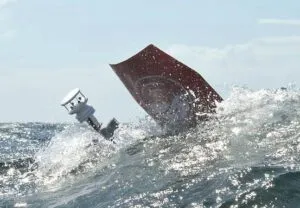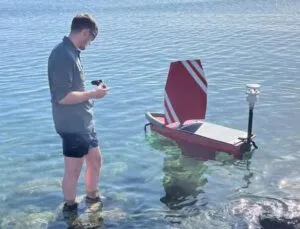Final test at St Thomas
The boats, just over a meter long and called C-Stars, will gather meteorological and oceanographic data for hurricane research and forecasting.
“Understanding weather conditions where the ocean surface meets the lower atmosphere is key to predicting hurricane intensity,” said NOAA oceanographer Greg Foltz. “If these miniature uncrewed surface vehicles prove reliable, they could become a critical piece of NOAA’s hurricane observing system in the future.”
The five C-Stars were set loose off the island of St Thomas in the British Virgins Islands, and are receiving instructions from NOAA and the University of Southern Mississippi via Oshen’s control centre in Southampton and a satellite link.
Largely, they are told where to go, and make their own way, sending their data back via satellite and storing high-resolution data on-board for later retrieval.

Initially they are to form a line across the Golf of Mexico (pink dots left – colours show autumn storm wind probability).
NOAA has two more C-Stars in reserve that can be taken out to sea and dropped in the right place if the other five can’t make their own way quickly enough.
On board, solar powered sensors record wind speed, wind direction, sea surface temperature, air temperature, air pressure and relative humidity. Electric thrusters back up wind power for manoeuvring.
 “Although C-Stars have navigated storms with 24 foot waves, hurricanes are a whole new level of challenge, but if it works the long-term potential is huge,” said Oshen CEO Anahita Laverack. “We believe that these small unmanned vehicles can move the needle in how we observe and understand hurricanes while keeping budgets under control.”
“Although C-Stars have navigated storms with 24 foot waves, hurricanes are a whole new level of challenge, but if it works the long-term potential is huge,” said Oshen CEO Anahita Laverack. “We believe that these small unmanned vehicles can move the needle in how we observe and understand hurricanes while keeping budgets under control.”
Recently, Oshen won a £2m contract from ARIA, the UK’s Advanced Research + Inventions Agency, to deploy a 50 C-Star fleet in the North Atlantic with the aim of predicting climate tipping points.
Saildrone makes similar, larger, sailing robots and has also worked with NOAA.

